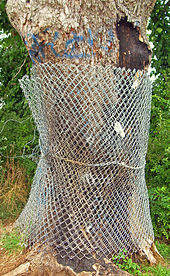Tree protection
The term tree protection is often used as a synonym for wood protection used. It stands for measures, legal norms or guidelines that are intended to protect individual trees or trees (several trees in an area) from mechanical or chemical damage. Damage or felling / clearing should be avoided or compensated for. Tree protection is particularly important for construction work , the operation of roads and commercial facilities , but also for agricultural or private use. The legal basis is the Federal Nature Conservation Act (BNatSchG).
Legal regulation in Germany
Tree protection is not standardized in Germany. State laws and especially statutes of the municipalities and others can contain further regulations. If such regulations do not exist, tree protection should be achieved in the event of interference with the natural balance through construction measures by applying §§ 18 and 19 BNatSchG ( intervention regulation ). From § 19 of the Federal Nature Conservation Act and the binding law of avoidance and minimization arises during construction. In the case of construction measures, this principle of avoidance is taken into account if at least DIN 18920 protection of trees during construction measures is complied with and RAS-LP 4 protection of trees, vegetation stands and animals is observed during construction measures and the trees for a period of at least three vegetation periods after completion the measure show no damage.
Many municipalities and cities have enacted tree protection or woodland protection statutes as legal norms. These contain a definition of the protected woody plants (e.g. according to the trunk circumference of trees or the crown circumference of bushes and shrubs). Most garden owners are also obliged to refrain from felling or other damage. Felling and habitat-changing interventions may require approval. An application may be necessary in which the trees to be felled or trees to be cut are named with the trunk circumference, type and vitality and must be mapped in a site plan. The competent authority (often the Lower Nature Conservation Authority ) can issue a permit and, depending on the statutes, stipulate compensatory and replacement measures.
Grandfathering
As a rule, trees, shrubs and hedges are protected from the 1st March to 30th September. Massive cutbacks are not permitted during this time. This regulation serves, among other things, to protect the nesting, living and breeding grounds of animals.
See also
Web links
- Tree statutes alone are not enough
- Tree protection in the construction area in Lindau (case example)
- Tree protection in Potsdam (case example)
- Information on tree protection in the district of Munich (case example)
Individual evidence
- ↑ grandfathering: hedge cutting is only allowed until the end of February. Advocard.de (accessed on March 18, 2016).
- ↑ Cut the hedge before spring. Heim.de (accessed on March 18, 2016).



